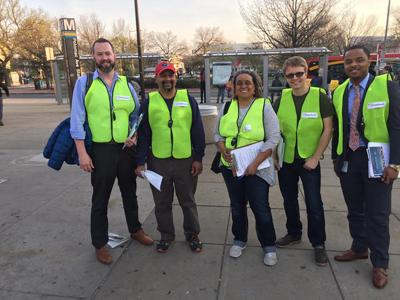Community Group Created to Enhance Safety
By • April 20, 2016 0 1779

A group of concerned D.C. residents have come together to start an organization that they hope, with any luck, won’t be around in five years.
DCSafetyNet is working to raise awareness and to suggest and try out solutions and tactics to keep residents safe.
The acting co-chair of DCSafetyNet, Richard Lukas, said that even though D.C. seems to have an interest group for everything imaginable, there was not one dedicated solely to the safety of its residents.
“We feel as citizen advocates, we are able to be flexible in trying things out that our government is not,” he said. “We feel by just putting out numbers about how much crime is happening, we are playing an accountable role for D.C. government.”
The Metropolitan Police Department reports that between the 2008 and 2012 homicide rates steadily decreased, but they began to rise again, with a 54 percent spike, between 2014 and 2015. The total number of violent crimes between 2014 and 2015 have seen a 2 percent increase, as well.
Wards 7 and 8, especially, have experienced an increase in violent crimes, including homicides, assaults with a dangerous weapon, robberies with a gun and theft. While D.C. officials have suggested several possible reasons for the 2015 increases, 2016 is on track to be just as violent.
Lukas said that since Metro adopted a policy to allow D.C. school children to ride for free, the Metro has become a “playground” for youth. In the past two weeks alone, two 15-year-old boys were killed at the Deanwood Metro station by other young males.
“Others have said many crimes are becoming more brazen,” Lukas said. “There are more daylight robberies, assaults and homicides, by youth, especially. They are taking up violence as the first way to resolve conflict.”
DCSafetyNet set up a pilot program called SafeRoutes, where volunteers wore bright green vests and carried whistles in case they witnessed crime happening. They were stationed outside the Potomac Avenue Metro stop between 5:30 and 7:30 p.m. to put more “eyes and ears” in the community. The goal was to make people feel safer while commuting.
During the two-week pilot program, Lukas said volunteers heard from many concerned neighbors that the SafeRoutes program instilled greater confidence in their ability to walk about their community safely.
“We have learned many valuable lessons,” he said. “This exercise allowed us to measure the community’s support for it, to hear how people feel about their neighborhood’s public safety and to learn what it takes to sustain such an initiative.”
Lukas said that if DCSafetyNet receives a commitment from 40 or more people to volunteer for one to two hours a month, a SafeRoute program can be set up at the Potomac Avenue Metro station.
“If there is enough community support for such an activity, we have a system in place that would allow us to continue the SafeRoutes program, including an IT framework for volunteers to sign-up and a stock of vests and personal safety alarms,” he said.
The SafeRoutes program is not the only resource DCSafetyNet offers to community members. They also promote neighborhood watch and self-defense trainings, in addition to advocating for more evenly distributed policing efforts in the District.
Although DCSafetyNet has not taken a stance on any policy issues thus far, Lukas said that in February a group of people within DCSafetyNet was launched to begin getting legislation passed.
Lukas hopes crime rates in D.C. decrease so DCSafetyNet will not be necessary five years from now.
“We want people to have confidence to walk around their neighborhoods,” he said. “We want people to have a happy and positive experience with DCSafetyNet.”

